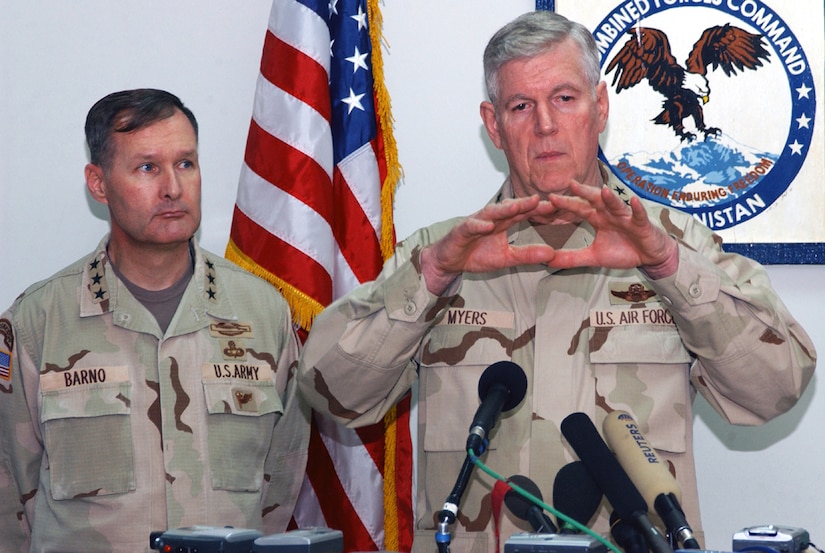When Air Force Gen. Richard B. Myers first heard of a plane flying into the World Trade Center on Sept. 11, 2001, he wondered how someone, on such a beautiful cloudless day, could do that.

Myers, a career pilot, who flew Wild Weasel missions over Vietnam hunting for enemy surface-to-air missiles, was on Capitol Hill that day preparing for a confirmation hearing to make him chairman of the Joint Chiefs of Staff.
When the second plane hit the other World Trade Center tower, he knew it was an attack.
Myers retired from the military after serving as chairman in 2005. He is now the president of Kansas State University in Manhattan, Kansas, and he spoke about his experiences on September 11, 2001, in an interview.
Although Myers was the vice chairman, on that day he was serving as acting chairman as Army Gen. Hugh Shelton was over the North Atlantic heading to NATO meetings in Europe.
Myers immediately left the Capitol to get back to the Pentagon. At that time, Flight 77 slammed into the Pentagon. "When I came across the 14th Street Bridge fire and black smoke were coming out of the Pentagon," Myers said. "It was one of those moments where I said, 'Okay, this is a dream,' because it just seemed surreal. I actually kind of slapped my face to make sure I was awake. And I just said, 'Okay, this is real.'"
"I got back and there was some talk about going to the continuity of government site, but I asked if the (National Military Command Center) was operating and we just headed there."
So, one side of the Pentagon was on fire, while on the other side of the building America's defense leaders were putting into place defenses against further terrorist attacks in the United States, on U.S. military bases overseas or against allies and partners.
"We knew pretty quickly that al-Qaida was behind the attacks," Myers said.
The United States knew Osama bin Laden was a danger and was looking for ways to get him before 9/11. "The [problem with] our intelligence at the time was we knew where he was, and where he had been, but we never knew how to predict where he was going to be," Myers said.
Looking back on the events of 9/11, Myers is proud of the way service members and DOD civilians responded to the attack. Even as half of the building still burned, thousands of Pentagon employees queued up to enter the building the next morning to do what they could to move forward.
That weekend at a Camp David meeting then-President George W. Bush gave the order to bring those who launched the attack to justice. "That was our marching order," Myers said.

Looking back two decades later, Myers thinks there are still lessons to be learned. The main one he stresses is the need for any effort like this to be a whole of government approach. "One of the things that occurs to me is … that we're over reliant on the military instrument of power," he said. "Every problem turned out to be a military problem."
The State Department, the Treasury Department, the Department of Homeland Security, the intelligence agencies, and more need to meld together to address any threat facing the United States, its citizens and national interests. "I think that was a huge mistake early on, not asking State and Treasury and Commerce, Justice, to participate," he said. "We said from the beginning that the military, alone, was never going to solve the problem of Afghanistan. "
"The War on Terror is really a war of ideas more than anything else," he said. "The military can do only so much in that."
He noted that the Founding Fathers were afraid of concentrating too
much power in the federal government. "James Madison would be proud: We
were not very efficient," Myers said. "And we are not efficient when it
comes to things like Afghanistan, where you need the whole of
government, all of national power, to come to play on that."
As an aside, Myers said he is always surprised by the connections that
still exist from 9/11. When he was on Capitol Hill, he didn't take an
aide with him. He just grabbed a young Army intern Capt. Chris Donahue,
to come along with him. Twenty years later, Army Maj. Gen. Chris
Donahue, the commander of the 82nd Airborne Division, was the last
American out of Afghanistan. "He saw the start and he saw the end,"
Myers said.
Myers understands the importance of 9/11 on his legacy. His official
portrait that hangs in the Joint Chiefs of Staff hallway in the Pentagon
has a small picture of him standing in front of the burned out wedge of
the building.







No comments:
Post a Comment